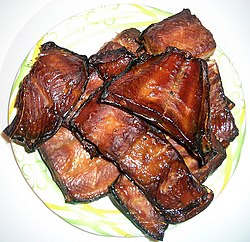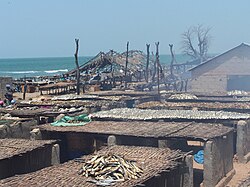


Hot-smoked chum salmon
Smoking is the process of flavoring, browning, cooking, or preserving food, particularly meat, fish and tea, by exposing it to smoke from burning or smoldering material, most often wood.
Contents
- History
- Types by method of application
- Cold smoking
- Warm smoking
- Hot smoking
- Liquid smoke
- Smoke roasting
- Types of fuel
- Wood smoke
- Types of smokers
- Offset
- Upright drum
- Vertical water
- Propane
- Smoke box
- Electric smokers
- Trench
- Commercial smokehouse
- Pellet smokers
- Preservation
- Competitive smoking
- Health concerns
- List of smoked foods and beverages
- See also
- References
- Further reading
- External links
In Europe, alder is the traditional smoking wood, but oak is more often used now, and beech to a lesser extent.[ clarification needed ] In North America, hickory, mesquite, oak, pecan, alder, maple, and fruit tree woods, such as apple, cherry, and plum, are commonly used for smoking. Other biomass besides wood can also be employed, sometimes with the addition of flavoring ingredients. Chinese tea-smoking uses a mixture of uncooked rice, sugar, and tea, heated at the base of a wok.
Some North American ham and bacon makers smoke their products over burning corncobs. Peat is burned to dry and smoke the barley malt used to make Scotch whisky and some beers. In New Zealand, sawdust from the native manuka (tea tree) is commonly used for hot-smoking fish. In Iceland, dried sheep dung is used to cold-smoke fish, lamb, mutton, and whale.
Historically, farms in the West included a smokehouse, a small building where meats could be smoked and stored. This was generally well separated from other buildings both because of fire danger and smoke emanations. The smoking of food may possibly introduce polycyclic aromatic hydrocarbons, which may lead to an increased risk of some types of cancer; however, this association is debated. [1] [2] [3] [4] [5] [ disputed – discuss ]
Food can be smoked by cold smoking, warm smoking or hot smoking. [6] However, these methods of imparting smoke only affect the food surface, and are unable to preserve food, thus, smoking is paired with other microbial hurdles, such as chilling and packaging, to extend food shelf-life. [6] Smoke-like flavor can be added by flavoring such as liquid smoke.















